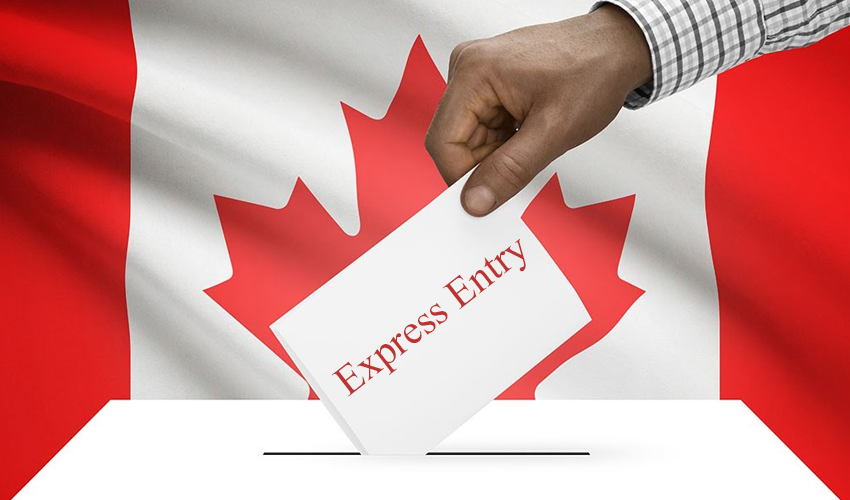Increase your CRS Score.
Increase your CRS Score.!

Finally, Immigration, Refugee and Citizenship Canada has announced first Express Entry draw for this year. The CRS score for this draw was 557. While the draw was quite disappointing, there are many ways to increase your score and get an ITA.
What is an ITA: An ITA is an Invitation to Apply which is given to the highest ranking candidates from the Express Entry pool. To clarify, Express Entry, is a point based system all candidates are ranked on the basis of their CRS score. Candidates in the pool are assigned points on the basis of their age, language, education, experience, etc.
Here are some factors that can increase your score:
1. Improve your language ability- Language score plays a vital role in improving CRS score of any candidate. So, if you can increase your IELTS/CELPIP, every band/point can make a big change!
2. Claim points for any sibling inside Canada, if applicable- If you have any brother or sister inside Canada who is a Canadian permanent resident/citizen, it could boost your score by 15 points.
3. Arranged employment- Arranged employment is a valid job offer, normally, supported by a positive LMIA from your employer. To mention, if you have a positive LMIA for 00 occupation, this will provide you 200 points separately. On the other hand, all other occupations(Skill level O, A and B) can get additional 50 points in their CRS score.
4. Provincial Nomination Program- If you have an approved PNP, it will provide you additional 600 points.
5. Experience- Non Canadian work experience is not as valuable as Canadian work experience because you will get more points for any experience inside Canada. However, foreign work experience still counts and provide you some additional points.
6. Stay informed- Most importantly, up-to-date information is always required for correct score. So, don’t forget to mention every qualifications and skills you have.!
Again, above are some common factors that can boost CRS score, these are not the only ones.!
A glance over Backlog
A Constant increase in IRCC's Applications Backlog

As of end of April 2022, the Immigration backlog has grown beyond 2.1 million across all immigration categories, as per the data obtained from the government. This is how the IRCC’s backlog has progresses since last summer:
- April 30-May 2, 2022: 2,130,385 applications
- April 11-12, 2022: 2,031,589 applications
- March 15 and 17, 2022: 1,844,424 applications
- February 1, 2022: 1,815,628 applications
- December 15, 2021: 1,813,144 applications
- October 27, 2021: 1,792,404 applications
- July 6, 2021: 1,447,474 applications
The application backlog continues to be a challenge to Canadian Immigration. In late January, Canadian Immigration Minister, Sean Fraser announced number of measures to tackle this situation. Those measures includes adopting new technology and hiring new staff. However, continuous increase in the application number raises a question mark on these measures.!
TFWP Update.
Recent Changes to TFWP..

In effect from 4th April 2022, Canadian government announces 5 major changes in the Temporary Foreign Worker Program. These steps are taken to overcome the labor shortage across Canada. Following are the announcements made by Minister of Employment, Workforce Development and Disability Inclusion, Carla Qualtrough:
1. To address the seasonal worker shortage, there will no longer be a limit to the number of low-wage positions that employers in seasonal industries, such as fish and seafood processing, can fill through TFW Program. Therefore, making permanent the Seasonal Cap Exemption that has been in place since 2015. In addition, the maximum duration of these positions will be increased from 180 days to 270 days per year.
2. The validity time period of the LMIAs (Labor Market Impact Assessment) has been increased from 9 months to 18 months.
3. The maximum duration of employment for High-Wage and Global Talent Stream workers will be extended from two years to three years. This extension will be beneficial for workers who want to access pathways to qualify for permanent residency, enabling them to contribute to Canadian workforce for the long-term.
4. Employers of sectors with demonstrated labor shortage will be allowed to hire 30% of their workforce through the TFWP for low-wage positions for one year. This includes employers from seven-sectors only. There is an increase of 10% cap for many employers.
5. Finally, Canada will end the current policy that automatically refuses LMIA applications for low-wage occupations in the accommodations, food services and retail trade sectors in regions with an unemployment rate of 6% or higher.
New Immigration Program of Saskatchewan
Saskatchewan announced Hard-to-Fill Skills Pilot Program

On November 25, Saskatchewan announced a new immigration pilot program to overcome the labor shortage in Saskatchewan. Although the eligibility for this program is not fully declared but this program will allow Saskatchewan employers to recruit international talent for some in-demand occupations. It is specifically designed for the labor shortage in certain occupations that includes manufacturing, health, agriculture, hospitality, construction, ag-tech, and retail.
In a media release, Immigration and Career Training Minister, Jeremy Harrison said that “The demand for labor in our province is strong, and it’s only going to increase with the significant economic projects recently announced in Saskatchewan. This new Hard-to-Fill Skills Pilot is progress on our autonomy discussions with the federal government and is going to help provide employers with greater access to international options to recruit workers. This is in addition to record investments into training and up-skilling our provincial workforce, as we enter a period of strong growth coming out of the global pandemic.”
This program is scheduled to launch in December 2021. The nominated workers of this program will be supported by their employers and the community.
Although it is not clearly declared, but some of the eligibility requirements for the employee include:
1. minimum Canadian official language proficiency level;
2. minimum educational and work experience requirements;
3. permanent job-offer and SINP job approval letter for an eligible occupation.
In addition to this, employers need to demonstrate their efforts to recruit the workers domestically before they can use this program to hire a worker internationally.
No further specifics have been released.
New TEER System..
New TEER System for Express Entry..

New TEER System is replacing NOC codes for the Express Entry Stream, this year. It is going to come into effect around fall of 2022. The National Occupation Classification plays a vital role in Immigration of Canada, especially, in Express Entry Stream. To clarify, temporary foreign workers are required to demonstrate their work experience in skill levels 0, A or B to be eligible for this stream. Therefore, replacement of NOCs with TEER is definitely something you need to know..!!
The new TEER system represents the degree of Training, Education, Experience and Responsibilities required for an occupation for Express Entry. Moreover, it will include a new five-digit hierarchical structure instead of 4-digit Skill Level structure of NOCs.
Overview of TEER System:
TEER 0: Management occupations.
TEER 1: 1. Completed a University degree (Bachelor’s, master’s or doctorate); or
2. Obtained several years of experience in a specific occupation from TEER 2.
TEER 2: 1. Completed post-secondary education program of two to three years at community college, institute of technology or CEGEP; or
2. Completed 2-5 years of an apprenticeship training program; or
3. Managed responsibilities of supervision or significant safety occupations; or
4. Obtained several years of experience in a specific occupation from TEER 3.
TEER 3: 1. Completed post-secondary education program of fewer than two years; or
2. Completed an apprenticeship training of fewer than two years; or
3. Obtained more than six months of on job training, undertook training courses or specific work experience with some secondary education; or
4. Have acquired several years of experience in a specific occupation from TEER 4.
TEER 4: 1. Completed secondary school; or
2. Obtained on job training for several weeks with some secondary school education; or
3. Have acquired several years of experience in specific occupation from TEER 5.
TEER 5: Short work demonstration and no formal education requirements.
TFWP Update.
Recent Changes to TFWP..!

In effect from 4th April 2022, Canadian government announces 5 major changes in the Temporary Foreign Worker Program. These steps are taken to overcome the labor shortage across Canada. Following are the announcements made by Minister of Employment, Workforce Development and Disability Inclusion, Carla Qualtrough:
1. To address the seasonal worker shortage, there will no longer be a limit to the number of low-wage positions that employers in seasonal industries, such as fish and seafood processing, can fill through TFW Program. Therefore, making permanent the Seasonal Cap Exemption that has been in place since 2015. In addition, the maximum duration of these positions will be increased from 180 days to 270 days per year.
2. The validity time period of the LMIAs (Labor Market Impact Assessment) has been increased from 9 months to 18 months.
3. The maximum duration of employment for High-Wage and Global Talent Stream workers will be extended from two years to three years. This extension will be beneficial for workers who want to access pathways to qualify for permanent residency, enabling them to contribute to Canadian workforce for the long-term.
4. Employers of sectors with demonstrated labor shortage will be allowed to hire 30% of their workforce through the TFWP for low-wage positions for one year. This includes employers from seven-sectors only. There is an increase of 10% cap for many employers.
5. Finally, Canada will end the current policy that automatically refuses LMIA applications for low-wage occupations in the accommodations, food services and retail trade sectors in regions with an unemployment rate of 6% or higher.
Work as a Childcare Provider in Canada
Home Child Care Provider Pilot reopening soon..
If you are planning to make Canada your dream home and like to spend time with children, then don’t miss this opportunity.
Home Child Care Provider Pilot allows working parents to hire a worker to take care of their children. You may be eligible to apply for Permanent Residence and Caregiver work permit at the same time through this program. However, for this you need to meet the eligibility of this Pilot Program.
To mention, through this Pilot you’ll get an open work permit to get into Canada and gain suitable work-experience you need for Permanent Residency. The work permit given is occupation-restricted and does not need a Labor Market Impact Assessment (LMIA).
Applicants must meet the following requirements in order to be considered for this program:
- language proficiency;
- education;
- work-experience;
- valid job offer from an eligible employer.
This program is reopening from January 1st, 2022 and is designed on First Come, First Serve basis. IRCC only process 2,750 application under this stream every year. So, if you are eligible for this program, make sure to submit your application ASAP.
Not sure about your eligibility..??? We are here to help. Contact us at info@primmigrationinc.com OR 6473003451

Immigrate from India to Canada
Immigration Options from India to Canada

In this article, we would discuss about some of the most common Immigration options from India. Every year thousands of Indian Immigrants make Canada their permanent home. If you want to be one of them, read this article till end.
Work after studies:
This is the most popular option of making a way towards Permanent Residency in Canada. Studies has revealed that almost half of the international students become a Permanent Resident of Canada within five years of completing their studies in Canada. Initially, the student completes his Canadian study and gain relevant work experience. This could make them eligible for Express Entry, which is one of the fastest way of Immigration in Canada.
Canadian Work- Permits:
Work permit holders can also apply for Canadian Permanent Residency if they have enough points in terms of age, experience, language efficiency, etc. To apply for right work-permit, an applicant should make sure the stream for which he is eligible. Some work permit stream are Labor Market Impact Assessment, Global Talent Stream, International Mobility Program, etc.
Family Sponsorships:
Canada is one of those countries which allow their residents to unite with their family members with an ease. Therefore, if you are a family member of a Canadian Permanent Resident or a Canadian Citizen, you might be eligible for family class sponsorship.
Express Entry:
There are various immigration programs in Express Entry which is the fastest way of becoming a Permanent Resident of Canada. This option includes Federal Skilled Trades Program, Federal Skilled Workers Program, Canadian Experience Class. If you are eligible for one of these programs, you can enter your information into the Express Entry pool of candidates, to get a Comprehensive Ranking System score. Finally, you will be invited to apply for Permanent Residency if you are one of the top ranked candidates.
Provincial Nominee Program:
Every province has its own system of selecting candidates for PNPs. Almost every province or territory of Canada participate in this program except Quebec and Nunavut. If you receive a Provincial Nominee from any province or territory, it would add 600 points in your CRS that could bring you to the top of Express Entry pool.
If you need more information or professional help to discuss your case, visit www.primmigrationinc.com
Recognition of Genuine Immigration Websites
How to avoid Immigration Fraud
Many people become victims of Immigration fraud every year as the people are less aware about the source of Immigration information online. As recently tweeted by IRCC, people must be careful when searching Immigration related information online. Following are some tips that can help you identify the immigration scams online. A website might be fake or a scam if:
1. the website ask you to pay to access the application forms and guides. IRCC only charge for the process of your application and all the forms and guides are available for free on IRCC website.
2. the website guarantee the positive decision of your application. No one can guarantee a positive decision for your application; it all depends on your eligibility for a particular class or stream.
3. the website looks like an official Government site but it is only in one language and does not have the canada.ca URL or a URL that ends with “.gc.ca”
4. the website ask your financial information or make a deposit before you even start the application process.
5. the website was advertised in an email from a stranger that you did not ask for.
6. the website do not have a contact information of any person to be contacted.
7. the website do not have company’s or representative’s credentials.
If you come across a fraudulent website, report it to your local police, and the Canadian Anti-Fraud Centre.
For more information on Immigration fraud from IRCC website, visit https://www.canada.ca/en/immigration-refugees-citizenship/services/protect-fraud/internet-email-telephone.html

